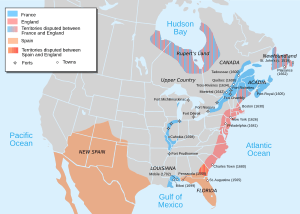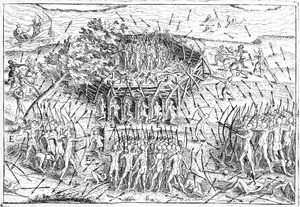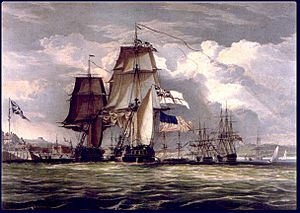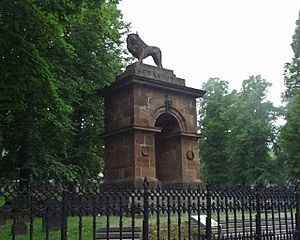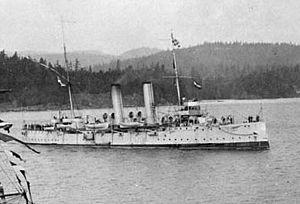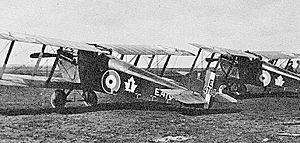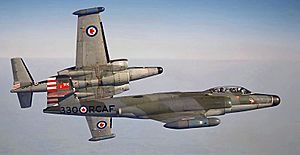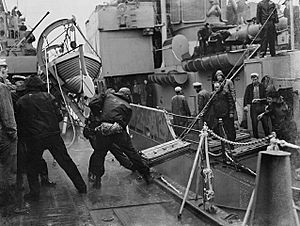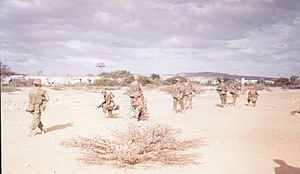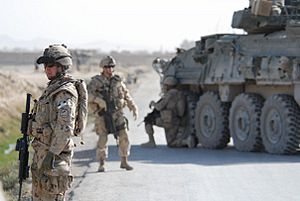Military history of Canada facts for kids

The military history of Canada comprises hundreds of years of armed actions in the territory encompassing modern Canada, and interventions by the Canadian military in conflicts and peacekeeping worldwide. For thousands of years, the area that would become Canada was the site of sporadic intertribal conflicts among Aboriginal peoples. Beginning in the 17th and 18th centuries, Canada was the site of four colonial wars and two additional wars in Nova Scotia and Acadia between New France and New England; the conflicts spanned almost seventy years, as each allied with various First Nation groups.
In 1763, after the final colonial war—the Seven Years' War—the British emerged victorious and the French civilians, whom the British hoped to assimilate, were declared "British Subjects". After the passing of the Quebec Act in 1774, giving the Canadians their first charter of rights under the new regime, the northern colonies chose not to join the American Revolution and remained loyal to the British crown. The Americans launched invasions in 1775 and 1812. On both occasions, the Americans were rebuffed by Canadian forces; however, this threat would remain well into the 19th century and partially facilitated Canadian Confederation in 1867.
After Confederation, and amid much controversy, a full-fledged Canadian military was created. Canada, however, remained a British dominion, and Canadian forces joined their British counterparts in the Second Boer War and the First World War. While independence followed the Statute of Westminster, Canada's links to Britain remained strong, and the British once again had the support of Canadians during the Second World War. Since then, Canada has been committed to multilateralism and has gone to war within large multinational coalitions such as in the Korean War, the Gulf War, the Kosovo War, and the Afghan war.
Indigenous
Indigenous warfare tended to be over tribal independence, resources, and personal and tribal honour—revenge for perceived wrongs committed against oneself or one's tribe. Before European colonization, indigenous warfare tended to be formal and ritualistic, and entailed few casualties. There is some evidence of much more violent warfare, even the complete genocide of some First Nations groups by others, such as the total displacement of the Dorset culture of Newfoundland by the Beothuk. Warfare was also common among indigenous peoples of the Subarctic with sufficient population density. Inuit groups of the northern Arctic extremes generally did not engage in direct warfare, primarily because of their small populations, relying instead on traditional law to resolve conflicts.
Those captured in fights were not always killed; tribes often adopted captives to replace warriors lost during raids and battles, and captives were also used for prisoner exchanges. Slavery was hereditary, the slaves being prisoners of war and their descendants. Slave-owning tribes of the fishing societies, such as the Tlingit and Haida, lived along the coast from what are now Alaska to California. Among indigenous peoples of the Pacific Northwest Coast, about a quarter of the population were slaves.
The first conflicts between Europeans and indigenous peoples may have occurred around 1003 CE, when parties of Norsemen attempted to establish permanent settlements along the northeastern coast of North America (see L'Anse aux Meadows). According to Norse sagas, the Skrælings of Vinland responded so ferociously that the newcomers eventually withdrew and gave up their plans to settle the area.
Prior to French settlements in the St. Lawrence River valley, the local Iroquoian peoples were almost completely displaced, probably because of warfare with their neighbours the Algonquin. The Iroquois League was established prior to major European contact. Most archaeologists and anthropologists believe that the League was formed sometime between 1450 and 1600. Existing indigenous alliances would become important to the colonial powers in the struggle for North American hegemony during the 17th and 18th centuries.
After European arrival, fighting between indigenous groups tended to be bloodier and more decisive, especially as tribes became caught up in the economic and military rivalries of the European settlers. By the end of the 17th century, First Nations from the northeastern woodlands, eastern subarctic and the Métis (a people of joint First Nations and European descent) had rapidly adopted the use of firearms, supplanting the traditional bow. The adoption of firearms significantly increased the number of fatalities. The bloodshed during conflicts was also dramatically increased by the uneven distribution of firearms and horses among competing indigenous groups.
17th century
Five years after the French founded Port Royal (see also Port-Royal (Acadia) and Annapolis Royal) in 1605, the English began their first settlement, at Cuper's Cove. By 1706, the French population was around 16,000 and grew slowly due to a multitude of factors. This lack of immigration resulted in New France having one-tenth of the British population of the Thirteen Colonies by the mid 1700s.
La Salle's explorations had given France a claim to the Mississippi River valley, where fur trappers and a few colonists set up scattered settlements. The colonies of New France: Acadia on the Bay of Fundy and Canada on the St. Lawrence River were based primarily on the fur trade and had only lukewarm support from the French monarchy. The colonies of New France grew slowly given the difficult geographical and climatic circumstances. The more favourably located New England Colonies to the south developed a diversified economy and flourished from immigration. From 1670, through the Hudson's Bay Company, the English also laid claim to Hudson Bay and its drainage basin (known as Rupert's Land), and chartered several colonies and seasonal fishing settlements on Newfoundland.
The early military of New France consisted of a mix of regular soldiers from the French Army (Carignan-Salières Regiment) and French Navy (Troupes de la marine and Compagnies Franches de la Marine) supported by small local volunteer militia units (Colonial militia). Most early troops were sent from France, but localization after the growth of the colony meant that, by the 1690s, many were volunteers from the settlers of New France, and by the 1750s most troops were descendants of the original French inhabitants. Additionally, many of the early troops and officers who were born in France remained in the colony after their service ended, contributing to generational service and a military elite. The French built a series of forts from Newfoundland to Louisiana and others captured from the British during the 1600s to the late 1700s. Some were a mix of military post and trading forts.
Anglo-Dutch Wars
The Second Anglo-Dutch War (1665 – 1667) was a conflict between England and the Dutch Republic partly for control over the seas and trade routes. In 1664, a year before the Second Anglo-Dutch War began, Michiel de Ruyter received instructions at Málaga on 1 September 1664 to cross the Atlantic to attack English shipping in the West Indies and at the Newfoundland fisheries in reprisal for Robert Holmes capturing several Dutch West India Company trading posts and ships on the West African coast. Sailing north from Martinique in June 1665, De Ruyter proceeded to Newfoundland, capturing English merchant ships and taking the town of St. John's before returning to Europe.
During the Third Anglo-Dutch War, the inhabitants of St. John's fended off a second Dutch attack in 1673. The city was defended by Christopher Martin, an English merchant captain. Martin landed six cannon from his vessel, Elias Andrews, and constructed an earthen breastwork and battery near Chain Rock commanding the Narrows leading into the harbour.
Beaver Wars
The Beaver Wars (also known as the French and Iroquois Wars) continued intermittently for nearly a century, ending with the Great Peace of Montreal in 1701. The French under Pierre Dugua, Sieur de Mons founded settlements at Port Royal and Samuel de Champlain three years later at Quebec City, quickly joining pre-existing aboriginal alliances that brought them into conflict with other indigenous inhabitants. Champlain joined a Huron–Algonquin alliance against the Iroquois Confederacy (Five/Six Nations). In the first battle, superior French firepower rapidly dispersed a massed group of aboriginals. The Iroquois changed tactics by integrating their hunting skills and intimate knowledge of the terrain with their use of firearms obtained from the Dutch; they developed a highly effective form of guerrilla warfare, and were soon a significant threat to all but the handful of fortified cities. Furthermore, the French gave few guns to their aboriginal allies.
For the first century of the colony's existence, the chief threat to the inhabitants of New France came from the Iroquois Confederacy, and particularly from the easternmost Mohawks. While the majority of tribes in the region were allies of the French, the tribes of the Iroquois confederacy were aligned first with the Dutch colonizers, then the British. In response to the Iroquois threat, the French government dispatched the Carignan-Salières Regiment, the first group of uniformed professional soldiers to set foot on what is today Canadian soil. After peace was attained, this regiment was disbanded in Canada. The soldiers settled in the St. Lawrence valley and, in the late 17th century, formed the core of the Compagnies Franches de la Marine, the local militia. Later militias were developed on the larger seigneuries land systems.
Civil war in Acadia
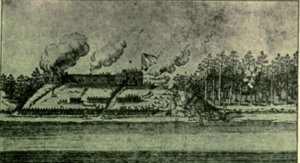
In the mid-17th century, Acadia was plunged into what some historians have described as a civil war. The war was between Port Royal, where Governor of Acadia Charles de Menou d'Aulnay de Charnisay was stationed, and present-day Saint John, New Brunswick, home of Governor Charles de Saint-Étienne de la Tour. During the conflict, there were four major battles. La Tour attacked d'Aulnay at Port Royal in 1640. In response to the attack, d'Aulnay sailed out of Port Royal to establish a five-month blockade of La Tour's fort at Saint John, which La Tour eventually defeated in 1643. La Tour attacked d'Aulnay again at Port Royal in 1643; d'Aulnay and Port Royal ultimately won the war against La Tour with the 1645 siege of Saint John. However, after d'Aulnay died in 1650, La Tour re-established himself in Acadia.
King William's War
During King William's War (1689–1697), the next most serious threat to Quebec in the 17th century came in 1690 when, alarmed by the attacks of the petite guerre, the New England colonies sent an armed expedition north, under Sir William Phips, to capture Quebec itself. This expedition was poorly organized and had little time to achieve its objective, having arrived in mid-October, shortly before the St. Lawrence would freeze over. The expedition was responsible for eliciting one of the most famous pronouncements in Canadian military history. When called on by Phips to surrender, the aged Governor Frontenac replied, "I will answer ... only with the mouths of my cannon and the shots of my muskets." After a single abortive landing on the Beauport shore to the east of Quebec City, the English force withdrew down the icy waters of the St. Lawrence.
During the war, the military conflicts in Acadia included: Battle at Chedabucto (Guysborough); Battle of Port Royal (1690); a naval battle in the Bay of Fundy (Action of 14 July 1696); Raid on Chignecto (1696) and Siege of Fort Nashwaak (1696). The Maliseet from their headquarters at Meductic on the Saint John River participated in numerous raids and battles against New England during the war.
In 1695, Pierre Le Moyne d'Iberville was called upon to attack the English stations along the Atlantic coast of Newfoundland in the Avalon Peninsula Campaign. Iberville sailed with his three vessels to Placentia (Plaisance), the French capital of Newfoundland. Both English and French fishermen exploited the Grand Banks fishery from their respective settlements on Newfoundland under the sanction of a 1687 treaty, but the purpose of the new French expedition of 1696 was nevertheless to expel the English from Newfoundland. After setting fire to St John's, Iberville's Canadians almost totally destroyed the English fisheries along the eastern shore of Newfoundland.
Small raiding parties attacked the hamlets in remote bays and inlets, burning, looting, and taking prisoners. By the end of March 1697, only Bonavista and Carbonear remained in English hands. In four months of raids, Iberville was responsible for the destruction of 36 settlements. At the end of the war England returned the territory to France in the Treaty of Ryswick.
18th century
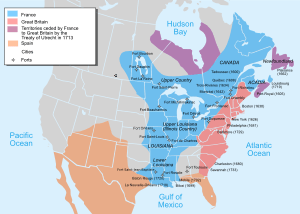
During the 18th century, the British–French struggle in Canada intensified as the rivalry worsened in Europe. The French government poured more and more military spending into its North American colonies. Expensive garrisons were maintained at distant fur trading posts, the fortifications of Quebec City were improved and augmented, and a new fortified town was built on the east coast of Île Royale, or Cape Breton Island—the fortress of Louisbourg, called "Gibraltar of the North" or the "Dunkirk of America".
New France and New England were at war with one another three times during the 18th century. The second and third colonial wars, Queen Anne's War and King George's War, were local offshoots of larger European conflicts—the War of the Spanish Succession (1702–13), the War of the Austrian Succession (1744–48). The last, the French and Indian War (Seven Years' War), started in the Ohio Valley. The petite guerre of the Canadiens devastated the northern towns and villages of New England, sometimes reaching as far south as Virginia. The war also spread to the forts along the Hudson Bay shore.
Queen Anne's War
During Queen Anne's War (1702–1713), the British conquered Acadia when a British force managed to capture Port-Royal (see also Annapolis Royal), the capital of Acadia in present-day Nova Scotia, in 1710. On Newfoundland, the French attacked St. John's in 1705 (Siege of St. John's), and captured it in 1708 (Battle of St. John's), devastating civilian structures with fire on each instance. As a result, France was forced to cede control of Newfoundland and mainland Nova Scotia to Britain in the Treaty of Utrecht (1713), leaving present-day New Brunswick as disputed territory and Île-St. Jean (Prince Edward Island), and Île-Royale (present day Cape Breton Island) in the hands of the French. British possession of Hudson Bay was guaranteed by the same treaty. During Queen Anne's War, military conflicts in Nova Scotia included the Raid on Grand Pré, the Siege of Port Royal (1707), the Siege of Port Royal (1710) and the Battle of Bloody Creek (1711).
Father Rale's War
During the escalation that preceded Father Rale's War (also known as Dummer's War), the Mi'kmaq raided the new fort at Canso (1720). Under potential siege, in May 1722 Lieutenant Governor John Doucett took 22 Mi'kmaq hostage at Annapolis Royal to prevent the capital from being attacked. In July 1722, the Abenaki and Mi'kmaq created a blockade of Annapolis Royal with the intent of starving the capital. The Mi'kmaq captured 18 fishing vessels and prisoners in the area stretching from present-day Yarmouth to Canso.
As a result of the escalating conflict, Massachusetts Governor Samuel Shute officially declared war on the Abenaki on July 22, 1722. Early operations of Father Rale's War happened in the Nova Scotia theatre. In July 1724, a group of sixty Mi'kmaq and Maliseets raided Annapolis Royal. The treaty that ended the war marked a significant shift in European relations with the Mi'kmaq and Maliseet. For the first time, a European empire formally acknowledged that its dominion over Nova Scotia would have to be negotiated with the region's indigenous inhabitants. The treaty was invoked as recently as 1999 in the Donald Marshall case.
King George's War
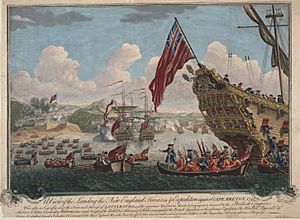
During King George's War, also called the War of the Austrian Succession (1744–1748), a force of New England militia under William Pepperell and Commodore Peter Warren of the Royal Navy succeeded in capturing Louisbourg in 1745. By the Treaty of Aix-la-Chapelle that ended the war in 1748, France resumed control of Louisbourg in exchange for some of its conquests in the Netherlands and India. The New Englanders were outraged, and as a counterweight to the continuing French strength at Louisbourg, the British founded the military settlement of Halifax in 1749. During King George's War, military conflicts in Nova Scotia included: Raid on Canso; Siege of Annapolis Royal (1744); the Siege of Louisbourg (1745); the Duc d'Anville expedition and the Battle of Grand Pré.
Father Le Loutre’s War
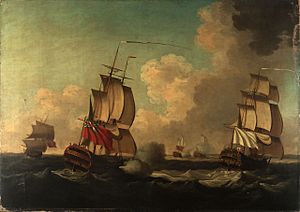
Father Le Loutre's War (1749–1755) was fought in Acadia and Nova Scotia by the British and New Englanders, primarily under the leadership of the New England Ranger John Gorham and the British officer Charles Lawrence, against the Mi'kmaq and Acadians, who were led by French priest Jean-Louis Le Loutre. The war began when the British established Halifax. As a result, Acadians and Mi'kmaq people orchestrated attacks at Chignecto, Grand-Pré, Dartmouth, Canso, Halifax and Country Harbour. The French erected forts at present-day Saint John, Chignecto and Fort Gaspareaux. The British responded by attacking the Mi'kmaq and Acadians at Mirligueche (later known as Lunenburg), Chignecto and St. Croix. The British also established communities in Lunenburg and Lawrencetown. Finally, the British erected forts in Acadian communities at Windsor, Grand-Pré and Chignecto.
Throughout the war, the Mi’kmaq and Acadians attacked the British fortifications of Nova Scotia and the newly established Protestant settlements. They wanted to retard British settlement and buy time for France to implement its Acadian resettlement scheme. The war ended after six years with the defeat of the Mi'kmaq, Acadians and French in the Battle of Fort Beauséjour. During this war, Atlantic Canada witnessed more population movements, more fortification construction, and more troop allocations than ever before in the region. The Acadians and Mi'kmaq left Nova Scotia during the Acadian Exodus for the French colonies of Île Saint-Jean (Prince Edward Island) and Île Royale (Cape Breton Island).
French and Indian War
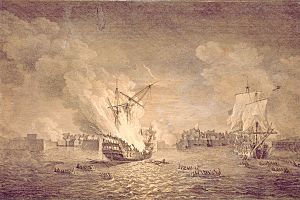
The fourth and final colonial war of the 18th century was the French and Indian War (1754–1763). The British sought to neutralize any potential military threat and to interrupt the vital supply lines to Louisbourg by deporting the Acadians. The British began the Expulsion of the Acadians with the Bay of Fundy Campaign (1755). During the next nine years, over 12,000 Acadians were removed from Nova Scotia. In the maritime theatre, conflicts included: Battle of Fort Beauséjour; Bay of Fundy Campaign (1755); the Battle of Petitcodiac; the Raid on Lunenburg (1756); the Louisbourg Expedition (1757); Battle of Bloody Creek (1757); Siege of Louisbourg (1758), Petitcodiac River Campaign, Gulf of St. Lawrence Campaign (1758), St. John River Campaign, and Battle of Restigouche.
In the St. Lawrence and Mohawk theatres of the conflict, the French had begun to challenge the claims of Anglo-American traders and land speculators for supremacy in the Ohio Country to the west of the Appalachian Mountains—land that was claimed by some of the British colonies in their royal charters. In 1753, the French started the military occupation of the Ohio Country by building a series of forts. In 1755, the British sent two regiments to North America to drive the French from these forts, but these were destroyed by French Canadians and First Nations as they approached Fort Duquesne. War was formally declared in 1756, and six French regiments of troupes de terre, or line infantry, came under the command of a newly arrived general, 44-year-old Marquis de Montcalm.
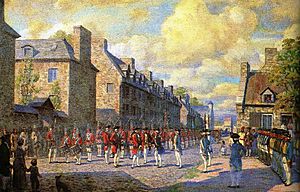
Under their new commander, the French at first achieved a number of startling victories over the British, first at Fort William Henry to the south of Lake Champlain. The following year saw an even greater victory when the British army—numbering about 15,000 under Major General James Abercrombie—was defeated in its attack on a French fortification at the Carillon. In June 1758, a British force of 13,000 regulars under Major General Jeffrey Amherst, with James Wolfe as one of his brigadiers, landed and permanently captured the Fortress of Louisbourg.
Wolfe decided the next year to attempt the capture of Quebec City. After several botched landing attempts, including particularly bloody defeats at the Battle of Beauport and the Battle of Montmorency Camp, Wolfe succeeded in getting his army ashore, forming ranks on the Plains of Abraham on September 12. Montcalm, against the better judgment of his officers, came out with a numerically inferior force to meet the British. In the ensuing battle, Wolfe was killed, Montcalm mortally wounded, and 658 British and 644 French became casualties. However, in the spring of 1760, the last French General, François Gaston de Lévis, marched back to Quebec from Montreal and defeated the British at the Battle of Sainte-Foy in a battle similar to that of the previous year; now the situation was reversed, with the French laying siege to Quebec. The siege lasted from 29 April until 15 May when British ships arrived to relieve the city which compelled Lévis to break off the siege and retreat.
The British were then able to launch the Montreal Campaign in the Summer of 1760 and by September the city capitulated; French resistance seized and the British Conquest of Canada was complete, this being confirmed by the Treaty of Paris.
American Revolutionary War
With the French threat eliminated, Britain's American colonies became increasingly restive; they resented paying taxes to support a large military establishment when there was no obvious enemy. This resentment was augmented by further suspicions of British motives when the Ohio Valley and other western territories previously claimed by France were not annexed to the existing British colonies, especially Pennsylvania and Virginia, which had long-standing claims to the region. Instead, under the Quebec Act, this territory was set aside for the First Nations. The American Revolutionary War (1776–1783) saw the revolutionaries use force to break free from British rule and claim these western lands.
In 1775, the Continental Army undertook its first military initiative of the war, the invasion of the British Province of Quebec. American forces took Montreal and the chain of forts in the Richelieu Valley, but attempts by the revolutionaries to take Quebec City were repelled. During this time, most French Canadians stayed neutral. After the British reinforced the province, a counter-offensive was launched pushing American forces back to Fort Ticonderoga. The counter-offensive brought an end to the military campaign in Quebec, and set the stage for the military campaign in upstate New York and Vermont in 1777.
Throughout the war, American privateers devastated the maritime economy by raiding many of the coastal communities. There were constant attacks by American and French privateers, such as the Raid on Lunenburg (1782), numerous raids on Liverpool, Nova Scotia (October 1776, March 1777, September 1777, May 1778, September 1780) and a raid on Annapolis Royal, Nova Scotia (1781). Privateers also raided Canso in 1775, returning in 1779 to destroy the fisheries.
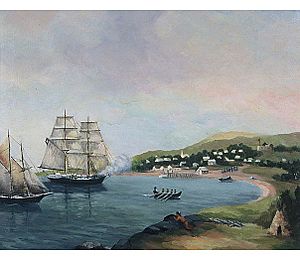
To guard against such attacks, the 84th Regiment of Foot (Royal Highland Emigrants) was garrisoned at forts around Atlantic Canada. Fort Edward (Nova Scotia) in Windsor became the headquarters to prevent a possible American land assault on Halifax from the Bay of Fundy. There was an American attack on Nova Scotia by land, the Battle of Fort Cumberland followed by the Siege of Saint John (1777).
During the war, American privateers captured 225 vessels either leaving or arriving at Nova Scotia ports. In 1781, for example, as a result of the Franco-American alliance against Great Britain, there was a naval engagement with a French fleet at Sydney, Nova Scotia, near Spanish River, Cape Breton. The British captured numerous American privateers, particularly in the naval battle off Halifax. The Royal Navy used Halifax as a base from which to launch attacks on New England, such as the Battle of Machias (1777).
The revolutionaries' failure to achieve success in what is now Canada, and the continuing allegiance to Britain of some colonists, resulted in the split of Britain's North American empire. Many Americans who remained loyal to the Crown, known as the United Empire Loyalists, moved north, greatly expanding the English-speaking population of what became known as British North America. The independent republic of the United States emerged to the south.
French Revolutionary Wars
During the War of the First Coalition, a series of fleet manoeuvres and amphibious landings took place on the coasts of the colony of Newfoundland. The French expedition included seven ships of the line and three frigates under Rear-Admiral Joseph de Richery and was accompanied by a Spanish squadron made up of 10 ships of the line under the command of General Jose Solano y Bote. The combined fleet sailed from Rota, Spain, with the Spanish squadron accompanying the French squadron in an effort to ward off the British that had blockaded the French in Rota earlier that year. The expedition to Newfoundland was the last portion of Richery's expedition before he returned to France.
Sighting of the combined naval squadron prompted defensives to be prepared at St. John's, Newfoundland in August 1796. Seeing these defences, Richery opted to not attack the defended capital, instead moving south to raid the undefended settlements, fishing stations and vessels, and a garrison base at Placentia Bay. After the raids on Newfoundland, the squadron was split up, with half moving on to raid neighbouring Saint Pierre and Miquelon, while the other half moved to intercept the seasonal fishing fleets off the coast of Labrador.
19th century
War of 1812
After the cessation of hostilities at the end of the American Revolution, animosity and suspicion continued between the United States and the United Kingdom, erupting in 1812 when the Americans declared war on the British. Among the reasons for the war was British harassment of US ships (including impressment of American seamen into the Royal Navy), a byproduct of British involvement in the ongoing Napoleonic Wars. The Americans did not possess a navy capable of challenging the Royal Navy, and so an invasion of Canada was proposed as the only feasible means of attacking the British Empire. Americans on the western frontier also hoped an invasion would not only bring an end to British support of aboriginal resistance to the westward expansion of the United States, but also finalize their claim to the western territories.
After the Americans launched an invasion in July 1812, the war raged back and forth along the border of Upper Canada, on land as well as on the waters of the Great Lakes. The British succeeded in capturing Detroit in July, and again in October. On July 12, US General William Hull invaded Canada at Sandwich (later known as Windsor). The invasion was quickly halted and Hull withdrew, giving General Isaac Brock the excuse he needed to abandon his previous orders and advance on Detroit, securing Shawnee chief Tecumseh's aid to do so. At this point, even with his aboriginal allies, Brock was outnumbered approximately two to one. However, Brock had gauged Hull as a timid man, and particularly as being afraid of Tecumseh's confederacy; he was thus able to convince Hull to surrender. The defeat of Detroit was utter and complete. A major American thrust across the Niagara frontier was defeated at the Battle of Queenston Heights, where Sir Isaac Brock lost his life.
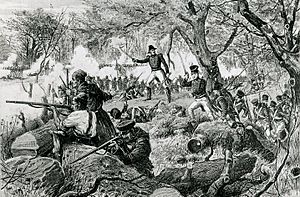
In 1813, the US retook Detroit and had a string of successes along the western end of Lake Erie, culminating in the Battle of Lake Erie (September 10) and the Battle of Moraviantown or Battle of the Thames on October 5. The naval battle secured US dominance of lakes Erie and Huron. At Moraviantown, the British lost one of their key commanders, Tecumseh. Further east, the Americans succeeded in capturing and burning York (later Toronto) and taking Fort George at Niagara, which they held until the end of the year. However, in the same year, two American thrusts against Montreal were defeated—one by a force of mostly British regulars at the Battle of Crysler's Farm southwest of the city on the St. Lawrence; the other, by a force of mostly French Canadian regular and militia units under the command of Charles de Salaberry, to the south of the city at the Battle of Châteauguay.
After the capture of Washington, DC, in September at the Battle of Bladensburg, the British troops burned down the White House and other government buildings, only to be repulsed as they moved north for the Battle of Baltimore, while the forces attacking during the Battle of New Orleans were routed after suffering severe casualties.
During the War of 1812, Nova Scotia's contribution to the war effort was made by communities either purchasing or building various privateer ships to lay siege to American vessels. Three members of the community of Lunenburg, Nova Scotia purchased a privateer schooner and named it Lunenburg on August 8, 1814. The vessel captured seven American vessels. The Liverpool Packet from Liverpool, Nova Scotia, another privateer vessel, is credited with having captured fifty ships during the conflict. Perhaps the most dramatic moment in the war for Nova Scotia was HMS Shannon's leading the captured American frigate USS Chesapeake into Halifax Harbour (1813). Many of the captives were imprisoned and died at Deadman's Island, Halifax.
Sir Isaac Brock became a martyred Canadian hero despite his British roots. The successful defence of Canada relied on Canadian militia, British regular troops (including "Fencible" units recruited within North America), the Royal Navy and aboriginal allies. Neither side of the war can claim total victory.
Historians agree that the Native Americans were the main losers of the war. The British dropped plans to create a neutral Indian state in the Midwest, and the coalition that Tecumseh had built fell apart with his death in 1813. The Natives no longer represented a major threat to westward expansion of the American frontier.
Construction of defences
The fear that the Americans might again attempt to conquer Canada remained a serious concern for at least the next half century, and was the chief reason for the retention of a large British garrison in the colony. From the 1820s to the 1840s, there was extensive construction of fortifications, as the British attempted to create strong points around which defending forces might centre in the event of an American invasion; these include the Citadels at Quebec City and Citadel Hill in Halifax, and Fort Henry in Kingston.
The Rideau Canal was built to allow ships in wartime to travel a more northerly route from Montreal to Kingston; the customary peacetime route was the St. Lawrence River, which constituted the northern edge of the American border, and thus was vulnerable to enemy attack and interference.
Rebellions of 1837
One of the most important actions by the British forces and Canadian Militia during this period was the putting down of the Rebellions of 1837, two separate rebellions from 1837 to 1838 in Lower Canada, and Upper Canada. As a result of the rebellion, the Canadas was merged into a single colony, the Province of Canada.
The Upper Canada Rebellion was quickly and decisively defeated by the British forces and Canadian Militia. Attacks the next year by Hunters' Lodges, US irregulars who expected to be paid in Canadian land, were crushed in 1838 in the Battle of Pelee Island and the Battle of the Windmill. The Lower Canada Rebellion was a greater threat to the British, and the rebels were victorious at the Battle of St. Denis on November 23, 1837. Two days later, the rebels were defeated at the Battle of Saint-Charles, and on December 14, they were finally routed at the Battle of Saint-Eustache.
British withdrawal
By the 1850s, fears of an American invasion had begun to diminish, and the British felt able to start reducing the size of their garrison. The Reciprocity Treaty, negotiated between Canada and the United States in 1854, further helped to alleviate concerns. However, tensions picked up again during the American Civil War (1861–65), reaching a peak with the Trent Affair of late 1861 and early 1862, touched off when the captain of a US gunboat stopped the RMS Trent and removed two Confederate officials who were bound for Britain. The British government was outraged and, with war appearing imminent, took steps to reinforce its North American garrison, increasing it from a strength of 4,000 to 18,000. However, war was averted and the sense of crisis subsided. This incident proved to be the final major episode of Anglo-American military confrontation in North America, as both sides increasingly became persuaded of the benefits of amicable relations. At the same time, many Canadians went south to fight in the Civil War, with most joining the Union side, although some were sympathetic toward the Confederacy.
Britain was at that time becoming concerned with military threats closer to home and disgruntled at paying to maintain a garrison in colonies that, after 1867, were united in the self-governing Dominion of Canada. Consequently, in 1871, the troops of the British garrison were withdrawn from Canada completely, save for Halifax and Esquimalt, where British garrisons remained in place purely for reasons of imperial strategy.
Enlistment in the British forces
Prior to Canadian Confederation, several regiments were raised in the Canadian colonies by the British Army, including the 40th Regiment of Foot, and the 100th (Prince of Wales's Royal Canadian) Regiment of Foot. A number of Nova Scotians fought in the Crimean War, with the Welsford-Parker Monument in Halifax, Nova Scotia, being the only Crimean War monument in North America. The monument itself is also the fourth oldest war monument in Canada, erected in 1860. It commemorates the Siege of Sevastopol (1854–1855). The first Canadian Victoria Cross recipient, Alexander Roberts Dunn, served in the war.
During the Indian Rebellion of 1857, William Nelson Hall, a descendant of former American slaves from Maryland, was the first black Canadian and first black Nova Scotian, to receive the Victoria Cross. He received the medal for his actions in the Siege of Lucknow.
Fenian raids
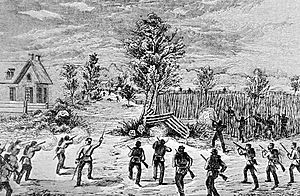
It was during the period of re-examination of the British military presence in Canada and its ultimate withdrawal that the last invasion of Canada occurred. It was not carried out by any official US government force, but by an organization called the Fenians. The Fenian raids (1866–1871) were carried out by groups of Irish Americans, mostly Union Army veterans from the American Civil War who believed that by seizing Canada, concessions could be wrung from the British government regarding their policy in Ireland. The Fenians had also incorrectly assumed that Irish Canadians, who were quite numerous in Canada, would support their invasive efforts both politically and militarily. However, most Irish settlers in Upper Canada at that time were Protestants of mostly either Anglo-Irish or Ulster-Scots descent, and for the most part loyal to the British Crown.
After the events of the Civil War, anti-British sentiment was high in the United States. British-built Confederate warships had wreaked havoc on US commerce during the war. Irish-Americans were a large and politically important constituency, particularly in parts of the Northeastern States, and a large number of Irish American regiments had participated in the war. Thus, while deeply concerned about the Fenians, the US government, led by Secretary of State William H. Seward, generally ignored their efforts: the Fenians were allowed to openly organize and arm themselves, and were even able to recruit in Union Army camps. The Americans were not prepared to risk war with Britain and intervened when the Fenians threatened to endanger American neutrality. The Fenians were a serious threat to Canada, as being veterans of the Union Army they were well-armed. Despite failures, the raids had some impact on Canadian politicians who were then locked in negotiations leading up to the Confederation agreement of 1867.
Canadian militia in the late–19th century
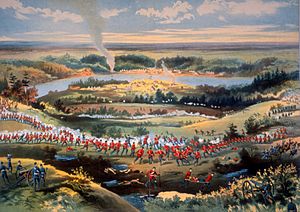
With Confederation in place and the British garrison gone, Canada assumed full responsibility for its own defence. The Parliament of Canada passed the Militia Act of 1868, modelled after the earlier Militia Act of 1855, passed by the legislature of the Province of Canada. However, it was understood that the British would send aid in the event of a serious emergency and the Royal Navy continued to provide maritime defence.
Small professional batteries of artillery were established at Quebec City and Kingston. In 1883, a third battery of artillery was added, and small cavalry and infantry schools were created. These were intended to provide the professional backbone of the Permanent Active Militia that was to form the bulk of the Canadian defence effort. In theory, every able-bodied man between the ages of 18 and 60 was liable to be conscripted for service in the militia, but in practice, the defence of the country rested on the services of volunteers who made up the Permanent Active Militia. Traditional sedentary militia regiments were retained as the Non-Permanent Active Militia.
The most important early tests of the militia were expeditions against the rebel forces of Louis Riel in the Canadian west. The Wolseley Expedition, containing a mix of British and militia forces, restored order after the Red River Rebellion in 1870. The North-West Rebellion in 1885 saw the largest military effort undertaken on Canadian soil since the end of the War of 1812: a series of battles between the Métis and their First Nations allies on one side against the Militia and North-West Mounted Police on the other.
The government forces ultimately emerged victorious despite having suffered a number of early defeats and reversals at the Battle of Duck Lake, the Battle of Fish Creek and the Battle of Cut Knife Hill. Outnumbered and out of ammunition, the Métis portion of the North-West Rebellion collapsed with the siege and Battle of Batoche. The Battle of Loon Lake, which ended this conflict, is notable as the last battle to have been fought on Canadian soil. Government losses during the North-West Rebellion amounted to 58 killed and 93 wounded.
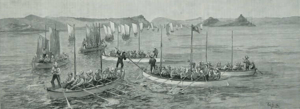
In 1884, Britain for the first time asked Canada for aid in defending the empire, requesting experienced boatmen to help rescue Major-General Charles Gordon from the Mahdi uprising in the Sudan. However, the government was reluctant to comply, and eventually Governor General Lord Lansdowne recruited a private force of 386 Voyageurs who were placed under the command of Canadian Militia officers. This force, known as the Nile Voyageurs, served in the Sudan and became the first Canadian force to serve abroad. Sixteen Voyageurs died during the campaign.
20th century
Boer War

The issue of Canadian military assistance for Britain arose again during the Second Boer War (1899–1902) in South Africa. The British asked for Canadian help in the conflict, and the Conservative Party was adamantly in favour of raising 8,000 troops for service in South Africa. English Canadian opinion was also overwhelmingly in favour of active Canadian participation in the war. However, French Canadians almost universally opposed the war, as did several other groups. This split the governing Liberal Party deeply, as it relied on both pro-imperial Anglo-Canadians and anti-imperial Franco-Canadians for support. Prime Minister Sir Wilfrid Laurier was a man of compromise. When deciding to send soldiers to South Africa, Laurier was worried about conflict between Anglo- and Franco-Canadians on the home front. Intimidated by his imperial cabinet, Laurier initially sent 1,000 soldiers of the 2nd (Special Service) Battalion of the Royal Canadian Regiment of Infantry. Later, other contingents were sent, 1st Regiment, Canadian Mounted Rifles and 3rd Battalion of The Royal Canadian Regiment (as 2nd Canadian Contingent) and including the privately raised Strathcona's Horse (as Third Canadian Contingent).
The Canadian forces missed the early period of the war and the great British defeats of Black Week. The Canadians in South Africa won much acclaim for leading the charge at the Second Battle of Paardeberg, one of the first decisive victories of the war. At the Battle of Leliefontein on November 7, 1900, three Canadians, Lieutenant Turner, Lieutenant Cockburn, Sergeant Holland and Arthur Richardson of the Royal Canadian Dragoons were awarded the Victoria Cross for protecting the rear of a retreating force. Ultimately, over 8,600 Canadians volunteered to fight. Lieutenant Harold Lothrop Borden, however, became the most famous Canadian casualty of the Second Boer War. About 7,400 Canadians, including many female nurses, served in South Africa. Of these, 224 died, 252 were wounded, and several were decorated with the Victoria Cross. Canadian forces also participated in the British-led concentration camp programs that resulted in the deaths of thousands of Boer civilians.
Expansion of the Militia
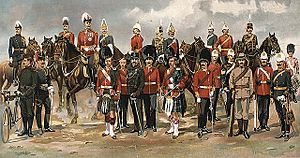
From 1763 to prior to the Confederation of Canada in 1867, the British Army provided the main defence of Canada, although many Canadians served with the British in various conflicts. As British troops left Canada in the late 19th and early 20th centuries, the importance of the Militia (comprising various cavalry, artillery, infantry and engineer units) became more pronounced. In 1883, the Government of Canada established its first permanent military forces. Shortly after Canada entered the Second Boer War, a debate developed over whether or not Canada should have its own army. As a result, the last Officer Commanding the Forces (Canada), Lord Dundonald, instituted a series of reforms in which Canada gained its own technical and support branches. In 1904, the Officer Commanding the Forces was replaced with a Canadian Chief of the General Staff. The new various "corps" included the Engineer Corps (1903), Signalling Corps (1903), Service Corps (1903), Ordnance Stores Corps (1903), Corps of Guides (1903), Medical Corps (1904), Staff Clerks (1905), and Army Pay Corps (1906). Additional corps would be created in the years before and during the First World War, including the first separate military dental corps.
Canada had long had a small fishing protection force attached to the Department of Marine and Fisheries, but relied on Britain for maritime protection. Britain was increasingly engaged in an arms race with Germany, and in 1908, asked the colonies for help with the navy. The Conservative Party argued that Canada should merely contribute money to the purchase and upkeep of some British Royal Navy vessels. Some French-Canadian nationalists felt that no aid should be sent; others advocated an independent Canadian navy that could aid the British in times of need.
Eventually, Prime Minister Laurier decided to follow this compromise position, and the Canadian Naval Service was created in 1910 and designated as the Royal Canadian Navy in August 1911. To appease imperialists, the Naval Service Act included a provision that in case of emergency, the fleet could be turned over to the British. This provision led to the strenuous opposition to the bill by Quebec nationalist Henri Bourassa. The bill set a goal of building a navy composed of five cruisers and six destroyers. The first two ships were Niobe and Rainbow, somewhat aged and outdated vessels purchased from the British. With the election of the Conservatives in 1911, in part because the Liberals had lost support in Quebec, the navy was starved for funds, but it was greatly expanded during the First World War.
First World War
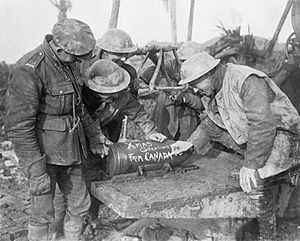
On August 4, 1914, Britain entered the First World War (1914–1918) by declaring war on Germany. The British declaration of war automatically brought Canada into the war, because of Canada's legal status as subservient to Britain. However, the Canadian government had the freedom to determine the country's level of involvement in the war. The Militia was not mobilized and instead an independent Canadian Expeditionary Force was raised. The highpoints of Canadian military achievement during the First World War came during the Somme, Vimy, and Passchendaele battles and what later became known as "Canada's Hundred Days".
The Canadian Corps was formed from the Canadian Expeditionary Force in September 1915 after the arrival of the 2nd Canadian Division in France. The corps was expanded by the addition of the 3rd Canadian Division in December 1915 and the 4th Canadian Division in August 1916. The organization of a 5th Canadian Division began in February 1917, but it was still not fully formed when it was broken up in February 1918 and its men used to reinforce the other four divisions. Although the corps was under the command of the British Army, there was considerable pressure among Canadian leaders, especially following the Battle of the Somme, for the corps to fight as a single unit rather than spreading the divisions. Plans for a second Canadian corps and two additional divisions were scrapped, and a divisive national dialogue on conscription for overseas service was begun.
Most of the other major combatants had introduced conscription to replace the massive casualties they were suffering. Spearheaded by Sir Robert Borden, who wished to maintain the continuity of Canada's military contribution, and with a burgeoning pressure to introduce and enforce conscription, the Military Service Act was ratified. Although reaction to conscription was favourable in English Canada the idea was deeply unpopular in Quebec. The Conscription Crisis of 1917 did much to highlight the divisions between French and English-speaking Canadians in Canada. In June 1918, HMHS Llandovery Castle was sunk by a U-boat. In terms of the number of dead, the sinking was the most significant Canadian naval disaster of the war. In the later stages of the war, the Canadian Corps were among the most effective and respected of the military formations on the Western Front.
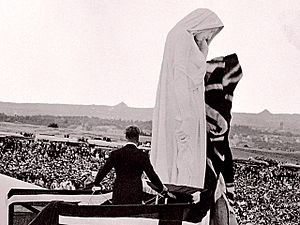
For a nation of eight million people, Canada's war effort was widely regarded as remarkable. A total of 619,636 men and women served in the Canadian forces in the First World War, and of these 59,544 were killed and another 154,361 were wounded. Canadian sacrifices are commemorated at eight memorials in France and Belgium. Two of the eight are unique in design: the giant white Vimy Memorial and the distinctive brooding soldier at the Saint Julien Memorial. The other six follow a standard pattern of granite monuments surrounded by a circular path: the Hill 62 Memorial and Passchendaele Memorial in Belgium, and the Bourlon Wood Memorial, Courcelette Memorial, Dury Memorial, and Le Quesnel Memorial in France. There are also separate war memorials to commemorate the actions of the soldiers of Newfoundland (which did not join Confederation until 1949) in the Great War. The largest are the Beaumont-Hamel Newfoundland Memorial and the Newfoundland National War Memorial in St. John's. The war's impact on Canadian society also led to the construction of a number of war memorials in Canada to commemorate the dead. Proposals to create a national memorial were first suggested in 1923; although work on the casts were not complete until 1933, with Canadian National War Memorial being unveiled in Ottawa in 1939. The monument currently commemorates Canadian war dead for several conflicts in the 20th– and 21st century.
In 1919, Canada sent a Canadian Siberian Expeditionary Force to aid the Allied intervention in the Russian Civil War. The vast majority of these troops were based in Vladivostok and saw little combat before they withdrew, along with other foreign forces.
Creation of a Canadian air force
The First World War was the catalyst for the formation of Canada's air force. At the outbreak of war, there was no independent Canadian air force, although many Canadians flew with the Royal Flying Corps and the Royal Naval Air Service. In 1914 the Canadian government authorized the formation of the Canadian Aviation Corps. The corps was to accompany the Canadian Expeditionary Force to Europe and consisted of one aircraft, a Burgess-Dunne, that was never used. The Canadian Aviation Corps was disbanded in 1915. A second attempt at forming a Canadian air force was made in 1918 when two Canadian squadrons (one bomber and one fighter) were formed by the British Air Ministry in Europe. The Canadian government took control of the two squadrons by forming the Canadian Air Force. This air force, however, never saw service and was completely disbanded by 1921.
During the 1920s the British government encouraged Canada to institute a peacetime air force by providing several surplus aircraft. In 1920 a new Canadian Air Force (CAF) directed by the Air Board was formed as a part-time or militia service providing flying refresher training. After a reorganization the CAF became responsible for all flying operations in Canada, including civil aviation. Air Board and CAF civil flying responsibilities were handled by the Royal Canadian Air Force (RCAF) after its creation in April 1924. The Second World War would see the RCAF become a truly military service.
Spanish Civil War
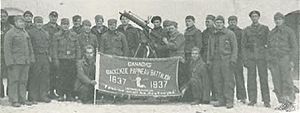
The Mackenzie–Papineau Battalion (a volunteer unit not authorized or supported by the Canadian government) fought on the Republican side in the Spanish Civil War (1936–1939). The first Canadians in the conflict were dispatched mainly with the US Abraham Lincoln Battalion and later the North American George Washington Battalion, with about forty Canadians serving in each group. By the summer of 1937 some 1,200 Canadians were involved in the conflict. They first engaged the fascists at the Battle of Jarama near Madrid, between February and June 1937, followed by the Battle of Brunete in July. Over the next year, Canadians fought in three major battles: the Battle of Teruel, the Aragon Offensive, and the Battle of the Ebro. In the battles in which they fought, 721 of the 1,546 Canadians known to have fought in Spain were killed. According to a speech given by Michaëlle Jean while unveiling the MacKenzie-Papineau Battalion Monument, "No other country gave a greater proportion of its population as volunteers in Spain than Canada".
Second World War

The Second World War (1939–1945) began following Nazi Germany's invasion of Poland on September 1, 1939. Canada's parliament supported the government's decision to declare war on Germany on September 10, one week after the United Kingdom and France. Canadian airmen played a small but significant role in the Battle of Britain, and the Royal Canadian Navy and Canadian merchant marine played a crucial role in the Battle of the Atlantic. C Force, two Canadian infantry battalions, were involved in the failed defence of Hong Kong. Troops of the 2nd Canadian Infantry Division also played a leading role in the disastrous Dieppe Raid in August 1942. The 1st Canadian Infantry Division and tanks of the independent 1st Canadian Armoured Brigade landed on Sicily in July 1943 and after a 38-day campaign took part in the successful Allied invasion of Italy. Canadian forces played an important role in the long advance north through Italy, eventually coming under their own corps headquarters in early 1944 after the costly battles on the Moro River and at Ortona.
On June 6, 1944, the 3rd Canadian Division (supported by tanks of the independent 2nd Canadian Armoured Brigade) landed on Juno Beach in the Battle of Normandy. Canadian airborne troops had also landed earlier in the day behind the beaches. By day's end, the Canadians had made the deepest penetrations inland of any of the five seaborne invasion forces. Canada went on to play an important role in the subsequent fighting in Normandy, with the 2nd Canadian Infantry Division coming ashore in July and the 4th Canadian Armoured Division in August. Both a corps headquarters (II Canadian Corps) and eventually an army headquarters—for the first time in Canadian military history—were activated. In the Battle of the Scheldt, the First Canadian Army defeated an entrenched German force at great cost to help open Antwerp to Allied shipping. The First Canadian Army fought in two more large campaigns; the Rhineland in February and March 1945, clearing a path to the Rhine River in anticipation of the assault crossing, and the subsequent battles on the far side of the Rhine in the last weeks of the war. The I Canadian Corps returned to northwest Europe from Italy in early 1945, and as part of a reunited First Canadian Army assisted in the liberation of The Netherlands (including the rescue of many Dutch from near-starvation conditions) and the invasion of Germany.
RCAF airmen served with RAF fighter and bomber squadrons, and played key roles in the Battle of Britain, antisubmarine warfare during the Battle of the Atlantic, and the bombing campaigns against Germany. Even though many RCAF personnel served with the RAF, No. 6 Group RAF Bomber Command was formed entirely of RCAF squadrons. Canadian air force personnel also provided close support to Allied forces during the Battle of Normandy and subsequent land campaigns in Europe. To free up male RCAF personnel who were needed on active operational or training duties, the RCAF Women's Division was formed in 1941. By the end of the war, the RCAF would be the fourth largest allied air force. In line with other Commonwealth countries, a women's corps entitled the Canadian Women's Army Corps, similar to the RCAF Women's Division, was established to release men for front-line duties. The corps existed from 1941 to 1946, was re-raised in 1948 and finally disbanded in 1964 (see Canadian women during the World Wars).
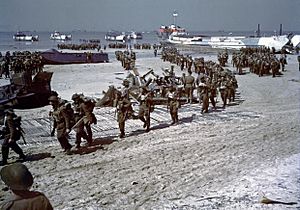
In addition to the army and air units, many thousands of Canadians also served with the Canadian Merchant Navy. Of a population of approximately 11.5 million, 1.1 million Canadians served in the armed forces during the Second World War. In all, more than 45,000 died, and another 55,000 were wounded. The Conscription Crisis of 1944 greatly affected unity between French and English-speaking Canadians on the home front, however it was not as politically intrusive as the conscription crisis of the First World War. Canada operated a benefits program similar to the American G.I. Bill for its Second World War veterans, with a strong economic impact similar to the American case.
Cold War years
Soon after the end of the Second World War, the Cold War (1946–1991) began. The formal onset of the Cold War, is usually credited to the 1945 defection of a Soviet cipher clerk working in Ottawa, Igor Gouzenko. This was the first event that led to "PROFUNC", a Government of Canada top secret plan to identify and detain communist sympathizers during the height of the Cold War. As a founding member of NATO and a signatory to the NORAD treaty with the US, Canada committed itself to the alliance against the Communist bloc. Canadian troops were stationed in Germany throughout the Cold War, and Canada joined with the Americans to erect defences against Soviet attack, such as the DEW Line. As a middle power, Canadian policy makers realized that Canada could do little militarily on its own, and thus a policy of multilateralism was adopted whereby Canada's international military efforts would be a part of a larger coalition. This led to Canada choosing to stay out of several wars despite the participation of close allies, most notably the Vietnam War and the Second Iraq War, although Canada lent indirect support and Canadian citizens served in foreign armies in both conflicts.
Forces in Europe
Canada maintained a mechanized infantry brigade in West Germany from the 1950s (originally the 27th Canadian Infantry Brigade, later named 4 Combat Group and 4 Canadian Mechanized Brigade) to the 1990s as part of Canada's NATO commitments. This brigade was maintained at close to full strength and was equipped with Canada's most advanced vehicles and weapons systems as it was anticipated the brigade might have to move quickly in the event of a Warsaw Pact invasion of the west. The Royal Canadian Air Force established No. 1 Air Division in the early 1950s to meet Canada's NATO air defence commitments in Europe.
Korean War
After the Second World War, Canada rapidly demobilized. When the Korean War (1950–1953) broke out, Canada needed several months to bring its military forces up to strength, and eventually formed part of British Commonwealth Forces Korea. Canadian land forces thus missed most of the early back-and-forth campaigns because they did not arrive until 1951, when the attrition phase of the war had largely started.
Canadian troops fought as part of the 1st Commonwealth Division, and distinguished themselves at the Battle of Kapyong and in other land engagements. HMCS Haida and other ships of the Royal Canadian Navy were in active service in the Korean War. Although the Royal Canadian Air force did not have a combat role in Korea, twenty-two RCAF fighter pilots flew on exchange duty with the USAF in Korea. The RCAF was also involved with the transportation of personnel and supplies in support of the Korean War.
Canada sent 26,791 troops to fight in Korea. There were 1,558 Canadian casualties, including 516 dead. Korea has often been described as "The Forgotten War", because for most Canadians it is overshadowed by the Canadian contributions to the two world wars. Canada is a signatory to the original 1953 armistice, but did not keep a garrison in South Korea after 1955.
Unification
In 1964 the Canadian government decided to merge the Royal Canadian Air Force, the Royal Canadian Navy and the Canadian Army to form the Canadian Armed Forces. The aim of the merger was to reduce costs and increase operating efficiency. Minister of National Defence Paul Hellyer argued in 1966 that "the amalgamation ... will provide the flexibility to enable Canada to meet in the most effective manner the military requirements of the future. It will also establish Canada as an unquestionable leader in the field of military organization." On February 1, 1968, unification was completed.
October Crisis
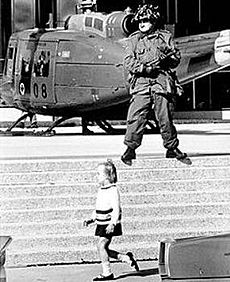
The October Crisis was a series of events triggered by two kidnappings of government officials by members of the Front de libération du Québec (FLQ) during October 1970 in the province of Quebec, mainly in the Montreal metropolitan area. During the domestic terrorist crisis Prime Minister Pierre Trudeau, when asked how far he was willing to go to resolving the problem, responded "Just watch me", a phrase that has become famous in Canadian lore. Three days later, on October 16, the circumstances ultimately culminated in the only peacetime use of the War Measures Act in Canada's history. The invocation of the act resulted in widespread deployment of 12,500 Canadian Forces troops throughout Quebec, with 7,500 troops stationed within the Montreal area.
Vietnam War
Canada did not fight in the Vietnam War (1955–1975) and officially had the status of a "non-belligerent". Canadian Forces involvement was limited to a small contingent in 1973 to help enforce the Paris Peace Accords. The war nevertheless had a considerable impact on Canadians. In a counter-current to the movement of American draft-dodgers and deserters to Canada, about 30,000 Canadians volunteered to fight in southeast Asia. Among the volunteers were fifty Mohawks from the Kahnawake reserve near Montreal. 110 Canadians died in Vietnam, and seven remain listed as Missing in Action.
Post–Cold War era
Oka Crisis
The Oka Crisis was a land dispute between a group of Mohawk people and the town of Oka in southern Quebec, which began on July 11, 1990, and lasted until September 26. On August 8, Quebec premier Robert Bourassa announced that he had invoked Section 275 of the National Defence Act to requisition military support in "aid of the civil power", a right available to provincial governments that was invoked after one police officer and two Mohawk were killed during the conflict. The Chief of the Defence Staff, General John de Chastelain placed Quebec-based troops in support of the provincial authorities. During Operation Salon, 2,500 regular and reserve troops were mobilized. Troops and mechanized equipment mobilized at staging areas around Oka and Montreal, while reconnaissance aircraft staged air photo missions over Mohawk territory to gather intelligence. Despite high tensions between military and First Nations forces, no shots were exchanged. On September 1, freelance photographer Shaney Komulainen took a photograph of men staring each other down. Entitled Face to Face, it has become one of Canada's most famous images.
Gulf War
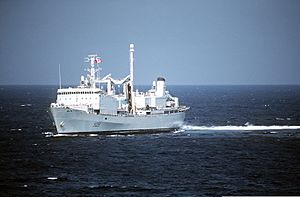
Canada was one of the first nations to condemn Iraq's invasion of Kuwait, and quickly agreed to join the US-led coalition. In August 1990, Prime Minister Brian Mulroney committed the Canadian Forces to deploy a Naval Task Group. The destroyers HMCS Terra Nova and HMCS Athabaskan joined the maritime interdiction force supported by the supply ship HMCS Protecteur. The Canadian Task Group led the coalition maritime logistics forces in the Persian Gulf. A fourth ship, HMCS Huron, arrived in-theatre after hostilities had ceased and was the first allied ship to visit Kuwait.
Following the UN authorized use of force against Iraq, the Canadian Forces deployed a CF-18 Hornet and Sikorsky CH-124 Sea King squadron with support personnel, as well as a field hospital to deal with casualties from the ground war. When the air war began, Canada's CF-18s were integrated into the coalition force and were tasked with providing air cover and attacking ground targets. This was the first time since the Korean War that the Canadian military had participated in offensive combat operations. The only CF-18 Hornet to record an official victory during the conflict was an aircraft involved in the beginning of the Battle of Bubiyan against the Iraqi Navy.
Yugoslav wars
Canada's forces were part of UNPROFOR, a UN peacekeeping force in Croatia and Bosnia and Herzegovina during the Yugoslav wars in the 1990s. Operation Medak pocket during that conflict was the largest battle fought by Canadian forces since the Korean War. The Canadian government claims that Canadian forces within the UN contingent clashed with the Croatian Army, where 27 Croatian soldiers were reported to have been killed. In 2002, the 2nd Battalion Princess Patricia's Canadian Light Infantry Battle Group were awarded the Commander-in-Chief Unit Commendation "for a heroic and professional mission during the Medak Pocket Operation".
Somali civil war
During the Somali Civil War, Prime Minister Brian Mulroney committed Canada to UNOSOM I after United Nations Security Council Resolution 751. UNOSOM I was the first part of the UN's response effort to provide security and humanitarian relief in Somalia, while monitoring UN-brokered ceasefires. Canadian forces, under the name Operation Deliverance, participated in the American-led Operation Restore Hope. In May 1993 the operation came under UN command and was renamed UNOSOM II. By its end, the mission had turned into a political disaster for the Canadian Forces. During the humanitarian mission Canadian soldiers killed a Somali teenager, leading to the Somalia Affair. Following an inquiry, the elite Canadian Airborne Regiment was disbanded and the reputation of the Canadian Forces suffered within Canada.
Red River flood
The 1997 Red River flood was the most severe flood of the Red River of the North since 1826, affecting North Dakota and Manitoba. A "public welfare emergency" was declared in the flood zone. During what was termed the "flood of the century", over 8,500 military personnel were sent to Manitoba to help with evacuation, building dikes, and other flood-fighting efforts, the largest single Canadian troop deployment since the Korean War. Operation Assistance was termed a "public relations bonanza" for the military: when a military convoy departed through Winnipeg in mid-May, thousands of civilians lined the streets to cheer for them.
North American ice storm
"Operation Recuperation" was in response to the North American ice storm of 1998, a massive combination of successive ice storms which combined to strike a relatively narrow swath of land from Lake Huron to southern Quebec to Nova Scotia, and bordering areas from northern New York to central Maine in the United States. Roads were impassable due to heavy snowfall or fallen trees, broken power lines and coated with a heavy layer of ice, emergency vehicles could hardly move. On January 7, the provinces of New Brunswick, Ontario, and Quebec requested aid from the Canadian Forces, and Operation Recuperation began on January 8 with 16,000 troops deployed. It was the largest deployment of troops ever to serve on Canadian soil in response to a natural disaster, and the largest operational deployment of Canadian military personnel since the Korean War.
21st century
Afghanistan War
Canada joined a US-led coalition in the 2001 attack on Afghanistan. The war was a response to the 9/11 terrorist attacks, and was intended to defeat the Taliban government and rout Al-Qaeda. Canada sent special forces and ground troops to the conflict. In this war, a Canadian sniper set the world record for the longest-distance kill. In early 2002, Canadian JTF2 troops were photographed handing shackled Taliban prisoners over to U.S. forces, sparking a debate of the Geneva Convention. In November 2005, Canadian military participation shifted from ISAF in Kabul to Operation Archer, a part of Operation Enduring Freedom in and around Kandahar. On May 17, 2006, Captain Nichola Goddard of the Royal Canadian Horse Artillery became Canada's first female combat casualty.
One of the most notable operations of the Canadian Forces in Afghanistan thus far was the Canadian-led Operation Medusa, during which the second Battle of Panjwaii was fought. At the end of 2006, the Canadian soldier was selected by the Canadian Press as the Canadian Newsmaker of the Year because of the war in Afghanistan. On November 27, 2010, the 1st Battalion of the Royal 22e Régiment took over operations in Kandahar, marking the final rotation before Canada's withdrawal from Afghanistan. In July 2011, a small contingent of Canadian troops was transferred to the NATO Training Mission-Afghanistan to continue the training of the Afghan National Army and Afghan National Police, until 2014.
British Columbia forest fires
"Operation Peregrine" was a domestic military operation that took place between August 3 and September 16, 2003. In early August 2003, British Columbia was overwhelmed by over 800 separate forest fires. Provincial fire services were stretched to the breaking point, and tens of thousands of people were forced to evacuate their homes. The provincial government requested federal aid, and within days, over 2,200 Canadian Forces personnel had been mobilized. The operation lasted 45 days, and at its height more than 2,600 military personnel were in action. It was the Canadian Forces third-largest recent domestic deployment, after "Operation Recuperation" in response to the 1998 ice storm, and "Operation Assistance" in response to the 1997 Red River flood.
Iraq War
The Iraq War (2003–2011) began with the invasion of Iraq on March 20, 2003. The government of Canada did not at any time officially declare war against Iraq. Nevertheless, the country's participation and relationship with the US was redefined at various points in that war. The Canadian Forces were involved in ship escort duties, and expanded their participation in Task Force 151 to free up American naval assets. About a hundred Canadian exchange officers, on exchange to American units, participated in the invasion of Iraq. There were numerous protests and counter-protests related to the conflict in Canada, and some United States Military members sought refuge in the country after deserting their posts to avoid deployment to Iraq.
Libyan civil war
On March 19, 2011, a multi-state coalition began a military intervention in Libya to implement United Nations Security Council Resolution 1973 in response to the 2011 Libyan civil war. Canada's contribution included the deployment of a number of naval and air assets, which were grouped together as part of Operation Mobile. NATO assumed control of military actions on March 25, with RCAF Lieutenant General, Charles Bouchard in command. A no-fly zone was put into effect during the civil war to prevent government forces loyal to Muammar Gaddafi from carrying out air attacks on anti-Gaddafi forces and civilians. The military intervention was enforced by NATO's Operation Unified Protector and included an arms embargo, a no-fly zone and a mandate to use all means necessary, short of foreign occupation, to protect Libyan civilians and civilian-populated areas. On October 28, 2011, Prime Minister Stephen Harper announced that the NATO military mission had ended successfully.
Mali conflict
Starting in early 2012 several insurgent groups in Mali started to take over the country. In January 2013 Mali asked for assistance from France to aid in ridding the country of the rebel insurgents. In December, the UN authorized an African intervention with the approval of the Economic Community of West African States. France then proceeded to ask its NATO allies to get involved, with Canada joining the effort by helping with the transportation of troops with a C-17 Globemaster. This was followed by twenty four Joint Task Force 2 members who entered the country to secure the Canadian embassy in the capital Bamako. A ceasefire agreement was signed on February 19, 2015 in Algiers, Algeria but sporadic terrorist attacks still occur.
Military intervention against ISIL
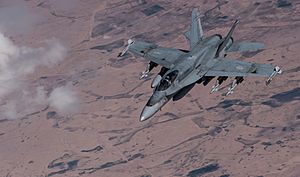
Operation Impact is the name of Canada's contribution to the military intervention against the Islamic State of Iraq and the Levant that began in September 2014. The first Canadian airstrike against an Islamic State target occurred on 2 November. It was reported that CF-18s successfully destroyed heavy engineering equipment used to divert the Euphrates River near the city of Fallujah. In October, then Prime Minister designate Justin Trudeau informed President Barack Obama that Canada intended to withdraw its fighter aircraft, while keeping its ground forces in Iraq and Syria.
Recent expenditures
The Constitution of Canada gives the federal government exclusive responsibility for national defence, and expenditures are thus outlined in the federal budget. For the 2007–2010 fiscal year, the amount allocated for defence spending was CA$6.15 billion which is 1.4 percent of the country's GDP. This regular funding was augmented in 2005 with an additional CA$12.5 billion over five years, as well as a commitment to increasing regular force troop levels by 5,000 persons, and the primary reserve by 4,500 over the same period. In 2010, a further CA$5.3 billion over five years was provided to allow for 13,000 more regular force members, and 10,000 more primary reserve personnel, as well as CA$17.1 billion for the purchase of new trucks for the Canadian Army, transport aircraft and helicopters for the Royal Canadian Air Force, and joint support ships for the Royal Canadian Navy. In July 2010, the largest purchase in Canadian military history, totalling CA$9 billion for the acquisition of 65 F-35 fighters, was announced by the federal government. Canada is one of several nations that assisted in the development of the F-35 and has invested over CA$168 million in the program. In 2010, Canada's military expenditure totaled approximately CA$122.5 billion.
Canadian Crown and the Forces
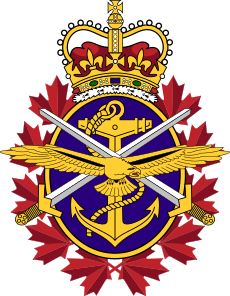
The Canadian Forces have derived many of their traditions and symbols from the military, navy and air force of the United Kingdom, including those with royal elements. Contemporary icons and rituals, however, have evolved to include elements reflective of Canada and the Canadian monarchy. Members of the country's Royal Family also continue their two-century-old practice of maintaining personal relationships with the forces' divisions and regiments, around which the military has developed complex protocols. The role of the Canadian Crown in the Canadian Forces is established through both constitutional and statutory law; the National Defence Act states that "the Canadian Forces are the armed forces of Her Majesty raised by Canada", and the Constitution Act, 1867 vests Command-in-Chief of those forces in the sovereign.
All honours in Canada emanate from the country's monarch, who is regarded as the fount of honour. A complex system of orders, decorations, and medals by which Canadians are honoured has evolved. The Victoria Cross, Order of Military Merit, Cross of Valour, Star of Courage, Medal of Bravery are some of the military awards that have been created for Canadians serving in a military capacity. The Victoria Cross has been presented to 94 Canadians and 2 Newfoundlanders between its creation in 1856 and 1993, when the Canadian Victoria Cross was instituted. However, no Canadian has received either honour since 1945.
During unification of the forces in the 1960s, a renaming of the branches took place, resulting in the "royal designations" of the navy and air force being abandoned. On August 16, 2011, the Government of Canada announced that the name "Air Command" was re-assuming the air force's original historic name, Royal Canadian Air Force, "Land Command" was re-assuming the name Canadian Army, and "Maritime Command" was re-assuming the name Royal Canadian Navy. The change was made to better reflect Canada's military heritage and align Canada with other key Commonwealth of Nations whose militaries use the royal designation.
Peacekeeping
Closely related to Canada's commitment to multi-lateralism has been its strong support for peacekeeping efforts. Canada's peacekeeping role during the 20th and 21st centuries has played a major part in its global image. Prior to Canada's role in the Suez Crisis, Canada was viewed by many as insignificant in global issues. Canada's successful role in the conflict gave Canada credibility and established it as a nation fighting for the "common good" of all nations. Canada participated in every UN peacekeeping effort from its inception until 1989. Since 1995, however, Canadian direct participation in UN peacekeeping efforts has greatly declined. In July 2006, for instance, Canada ranked 51st on the list of UN peacekeepers, contributing 130 peacekeepers out of a total UN deployment of over 70,000. Where in November 1990 Canada had 1,002 troops out of a total UN deployment of 10,304, that number decreased largely because Canada began to direct its participation to UN-sanctioned military operations through NATO, rather than directly to the UN.
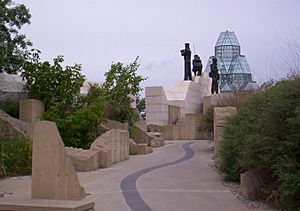
Canadian Nobel Peace Prize laureate Lester B. Pearson is considered to be the father of modern peacekeeping. Pearson had become a very prominent figure in the United Nations during its infancy, and found himself in a peculiar position in 1956 during the Suez Crisis: Pearson and Canada found themselves stuck between a conflict of their closest allies, being looked upon to find a solution. During United Nations meetings Lester B. Pearson proposed to the security council that a United Nations police force be established to prevent further conflict in the region, allowing the countries involved an opportunity to sort out a resolution. Pearson's proposal and offer to dedicate 1,000 Canadian soldiers to that cause was seen as a brilliant political move that prevented another war.
The first Canadian peacekeeping mission, even before the creation of the formal UN system, was a 1948 mission to the second Kashmir conflict. Other important missions include those in Cyprus, Congo, Somalia, Yugoslav, and observation missions in the Sinai Peninsula and Golan Heights. The loss of nine Canadian peacekeepers when their Buffalo 461 was shot down over Syria in 1974 remains the largest single loss of life in Canadian peacekeeping history. In 1988, the Nobel Peace Prize was awarded to United Nations peacekeepers, inspiring the creation of the Canadian Peacekeeping Service Medal to recognize Canadians, including serving and former members of the Canadian Forces, members of the Royal Canadian Mounted Police, other police services, and civilians, who contributed to peace on certain missions.
See also
 In Spanish: Historia militar de Canadá para niños
In Spanish: Historia militar de Canadá para niños



